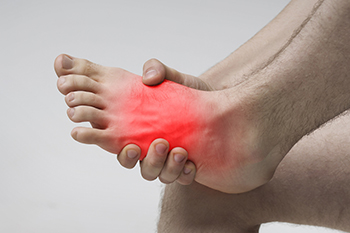
The feet are the main instrument in a runner’s orchestra. Because they take a pounding with every step taken, injuries are apt to occur. Two common causes of forefoot foot pain in runners, stress fractures and extensor tendonitis, can be difficult to tell apart. A stress fracture is a tiny hairline crack that often occurs in the metatarsals. Stress fractures may be caused by increasing speed and distance of a run too rapidly. Over time, the metatarsal bones weaken ever so slowly until they crack. Extensor tendonitis is an inflammation of the network of tendons that run across the top of the foot. They affect the same part of the forefoot, but can be differentiated by a simple test of moving the toes against a bit of force. If that movement causes pain, then you probably do not have a stress fracture. The most common causes of extensor tendonitis can be traced to improper footwear, tight Achilles tendons, or tight calf muscles. For an expert diagnosis of the cause of forefoot pain, it is suggested that you make an appointment with a podiatrist, who is medically trained in dealing with problems of the feet.
Ankle and foot injuries are common among athletes and in many sports. They can be caused by several problems and may be potentially serious. If you are feeling pain or think you were injured in a sporting event or when exercising, consult with one of our podiatrists from Family Foot Care of Long Island. Our doctors will assess your condition and provide you with quality foot and ankle treatment.
Common Injuries
The most common injuries that occur in sporting activities include:
- Achilles Tendonitis
- Achilles Tendon Rupture
- Ankle Sprains
- Broken Foot
- Plantar Fasciitis
- Stress Fractures
- Turf Toe
Symptoms
Symptoms vary depending upon the injury and in some cases, there may be no symptoms at all. However, in most cases, some form of symptom is experienced. Pain, aching, burning, bruising, tenderness, tightness or stiffness, sensation loss, difficulty moving, and swelling are the most common symptoms.
Treatment
Just as symptoms vary depending upon the injury, so do treatment options. A common treatment method is known as the RICE method. This method involves rest, applying ice, compression and elevating the afflicted foot or ankle. If the injury appears to be more serious, surgery might be required, such as arthroscopic or reconstructive surgery. Lastly, rehabilitation or therapy might be needed to gain full functionality in the afflicted area. Any discomfort experienced by an athlete must be evaluated by a licensed, reputable medical professional.
If you have any questions, please feel free to contact our office located in Port Jefferson Station, NY . We offer the newest diagnostic and treatment technologies for all your foot care needs.
